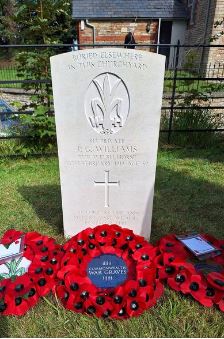2/1st Battalion, Welsh Horse Yeomanry

Percy Griffin Wiliams was born in Cheltenham about July 1887: his parents were Reuben Williams (1858-1914), a labourer and his wife Frances Mary (née Drinkwater: 1857-1910). According to the 1911 Census the couple had seven children, one of whom was deceased by that date.
Percy lived with his family in Cheltenham until after the time of the 1901 Census. On 6 February 1907 he married Minnie Florence Howley (1854-1957), at Oxenhall. The marriage was reported in the Gloucestershire Echo of 7 February. At that time Percy’s occupation was as a labourer. The couple had two children, Lyndon Samuel Probyn (born 14 July 1908) and Raymond Leslie (23 June 1910). The 1911 Census shows Percy and family living at Line House Cottage, near Newent. Percy was employed as a waggoner on a farm.
At least part of an Army Pension Record has survived for Percy. This reveals that he voluntarily enlisted for service in the Army, for the duration of the war, on 23 January 1915 at Gloucester. He stated his domicile to be Newent, his age 28 years and 6 months and occupation farm labourer. He requested to join the ‘Welsh Horse’.
He was duly embodied into the Welsh Horse Reserve and on 10 February 1916 was posted as a Private to 2/1st Welsh Horse Yeomanry (WHY). He was promoted to Corporal on 11 May 1916. The WHY three separate Territorial Force battalions, designated 1/1st, 2/1st and 3/1st. Percy appears to have been posted to the second line 2/1st, which had been formed in Newtown in 1914 and from July 1915 had become the 2/1st South Wales Mounted Brigade, based in the Doncaster area; moving in September 1915 to Suffolk, in the Yoxford area, where it joined 1st Mounted Division. In 1916 it was absorbed into the 2/1st Montgomeryshire Yeomanry. Percy did not serve abroad.
On 16 February 1917 he went before a medical board, at Blyburgh, Southwold, Suffolk. The board heard that he had been spitting blood everyday for a month, which he believed was due to a fall from a horse. He also had a persistent cough and had experienced weight loss. Prior to enlistment he had enjoyed good health. The medical board diagnosed pulmonary tuberculosis, which they deemed was not caused by the strain of ordinary military service but aggravated by it. He was declared permanently unfit and was discharged as being ‘no longer physically fit for war service’ on 26 March 1917. Interestingly, his discharge papers state his occupation to be a ‘horse breaker’. He was granted a disability pension, on the basis of total disablement, for two months and 50% disablement permanently. He was issued with a Silver War Badge, to signify previous military service.
It may be assumed that Private Percy Griffin Williams died from tuberculosis (for which, at that time, there was little effective treatment) at Newent on 13 February 1919, aged 32. He was buried in the churchyard of St Anne’s, Oxenhall on the 17th. Although an Army Pensioner, he was overlooked as a casualty of the Great War, until 2016 when, following local research, the In From the Cold Project submitted documentary evidence to the CWGC, who eventually confirmed his status and a ‘Special Memorial’ headstone, inscribed ‘Buried elsewhere in this Churchyard, was installed in 2023.
Researched by Graham Adams 22 May 2021 (revised October 2024)
